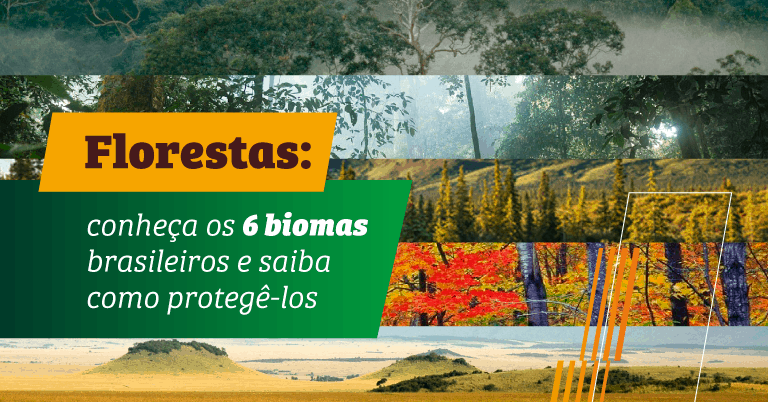Have you ever stopped to think about the importance of forests for the preservation of life on Earth? They supply oxygen, increase air humidity, control temperature, preserve rivers and reduce pollution. According to the United Nations (UN), forests cover 30.6% of the entire surface of the planet.
But do you know what forests are and what everyone can do to preserve them? Continue reading this text to find out.
WHAT ARE FORESTS ?
Basically, a forest is any area of land covered with lots of trees. Their top parts, called crowns, also touch and form a kind of green roof. But, according to the UN, forests are areas of more than 0.5 hectares with trees greater than five meters in height and canopy coverage of more than 10%. They are also popularly called mata, bush, grove and jungle.
WHAT ARE THE TYPES OF FORESTS ?
Forests that are in their original state, without human intervention, are classified as natural. Those that were produced by humans for production or conservation purposes, as planted. Forests can also be homogeneous, that is, made up of one or a few species of trees. When they are located on the banks of rivers, lakes and dams, they are called riparian forests.
WHAT ARE THE BRAZILIAN FORESTS ?
In Brazil, we find six biomes: Amazon, Caatinga, Cerrado, Atlantic Forest, Pampas and Pantanal.
Amazon
Large trees with closed crowns and wide leaves form one of the most important biomes in the world: the Amazon Rainforest. It is present in the states of Amazonas, Pará, Roraima, Rondônia, Acre, Amapá, Maranhão, Tocantins and part of Mato Grosso.
It represents about 30% of the world’s tropical forests, being part of other countries such as Venezuela, Colombia, Peru, Bolivia, Ecuador, Suriname, Guyana and French Guiana.
Caatinga
The Caatinga is a biome found only in Brazil, in the states of Ceará, Rio Grande do Norte, Paraíba, Pernambuco, Alagoas, Bahia, Piauí, Sergipe and in the north of Minas Gerais. The Caatinga is formed by low trees, with crooked trunks and thorns. Its roots cover the ground to store water during rains. In the dry period, the leaves of most species fall to prevent water loss.
Cerrado
More than 12,000 native species can be found in the Cerrado, predominantly shrubs and trees with twisted trunks. To adapt to the dry climate with many fires, the vegetation has a large capacity to store water. According to the Brazilian Forest Service, the Cerrado is the richest savannah on the planet and is part of the states of Goiás, Tocantins, Maranhão, Piauí, Bahia, Mato Grosso, Mato Grosso do Sul, Minas Gerais, São Paulo and the Federal District .
Atlantic Forest
Considered one of the greatest biodiversities on the planet, the Atlantic Forest is home to more than 20,000 medium and large plant species. It occupies approximately 13% of the Brazilian territory and is present in 17 states: Rio Grande do Sul, Santa Catarina, Paraná, São Paulo, Goiás, Mato Grosso do Sul, Rio de Janeiro, Minas Gerais, Espírito Santo, Bahia, Alagoas, Sergipe, Paraíba, Pernambuco, Rio Grande do Norte, Ceará and Piauí.
Pampas
In this biome present only in Rio Grande do Sul, the predominant vegetation is herbaceous, but there are araucarias in the transition areas. Also known as Campos do Sul, it extends over two neighboring countries of Brazil: Uruguay and Argentina.
HOW TO PROTECT THE FORESTS?
With small attitudes in our daily lives, it is possible to protect forests and, consequently, preserve the planet. Check out some of them:
Do not throw garbage in the environment. The ideal is to separate organic waste from wet waste for selective collection;
Put the 3 Rs of Sustainability (Reduce, Reuse and Recycle) into practice;
Prioritize recycled and recyclable papers;
Do not throw cigarettes in wooded areas;
Buy certified wood products;
Do not set fire to vegetation.
CATTEGRAN ACTIONS TO PROTECT FORESTS
Environmental responsibility is one of Cattegran’s pillars. For over 10 years, the company has carried out an Environmental Education project in partnership with schools in the Northern Region of Espírito Santo, where it is located. More than four thousand seedlings of native plants are distributed every year, such as jatobá, brazilwood, pink jequitibá, yellow ipe and jacaranda.
Cattegran is also working on the recovery of an area of 8.5 hectares in São Domingos do Norte, a municipality in the region. Various species will be planted on the site, such as araçaúna, cherry, mahogany, yellow ipê, white paineira, ingá-mirim and pau-d’alho.
In this text, you learned about the concepts of forest and the six existing biomes in Brazil and got to know the work of Environmental Education developed by Cattegran. Do you want to visit us and learn more about our actions to preserve the environment? Get in touch with our sales team and schedule a visit.

